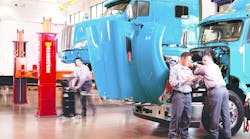Maintenance software has turned into a critically important tool to help vehicle shops optimize the use of resources – manpower, equipment, material and funds, control costs and keep equipment on the road. This software enables shop managers to better plan and manage their day-to-day operations and maintenance activities.
Maintenance software, which provides tools to support improved maintenance practices, has become even more important now that the Federal Motor Carrier Safety Administration's Compliance, Safety, Accountability (CSA) program requires state and federal roadside inspectors to look closely at a company’s maintenance records and driver inspection reports.
Industry-leading maintenance management systems, such as Connect CMMS (computerized maintenance management systems), are helping maintenance professionals maximize technician productivity, optimize parts inventories and improve CSA compliance. Companies that employ maintenance management systems not only stand a better chance of meeting federal standards, they also stand to gain a competitive advantage by reducing costs and boosting profitability.
Dozens of system providers offer maintenance management systems with what can be a befuddling choice of system features. For those in the market for a computerized managed maintenance system, look for 15 must-have features:
1. Manages PM schedules to maximize equipment uptime.
Equipment downtime is costly and, in many cases, could have been prevented. Look for equipment maintenance systems that allow users to easily create maintenance schedules so that shop supervisors and fleet managers can coordinate repairs and routine maintenance. The system should then automatically notify managers, dispatchers and drivers or operators when individual pieces of equipment are due for required preventive maintenance.
An effective system will deliver those maintenance reminders via multiple conduits, such as system-generated emails, management reports and as reminders displayed on the technicians' work orders.
These features ensure that preventive maintenance is completed on schedule so that equipment can quickly get back to work. Studies consistently show that for every $1 invested in preventive maintenance, breakdown costs are reduced by $4.
2. Manages and tracks parts costs.
Because controlling parts acquisition costs is critical to controlling equipment maintenance costs, a maintenance management system should make it easy to eliminate duplicate orders, track special parts orders or compare a part’s current cost to either prior purchases or a standard cost.
A robust system will offer multiple searchable data points, allowing managers to see who created the purchase order and which supplier was used so that they can identify and correct any potential issues before their companies are billed. If the maintenance management system is sold by a parts supplier, the parts supplier may offer special rebates for purchases made through that system.
3. Manages parts inventory accurately.
Year after year, surveys show that poor control of parts inventory is the major pain point for fleets and independent service garages. A well-designed inventory control function helps shops maintain accurate physical inventories.
Once shops complete an accurate physical parts count, users can maintain that accuracy by tracking when parts arrive and when they are taken out of inventory and issued to specific work orders. Through the use of tethered or portable barcode scanners and a barcode label printer, shops can further automate this process.
Inventory aging reports gives the parts manager a list of items that have not moved from the shelves in a specified date range and provides the sales history with the value of the affected inventory.
4. Provides an automated parts reorder process.
CMMS systems should offer a variety of ways to control inventory. Periodic parts orders based on min/max inventory settings allow a shop to maintain an adequate supply of parts important to the company’s everyday operations.
An automated parts replenishment feature will automatically reorder critical parts to ensure that these parts remain in stock. When a part is issued to a work order, the auto-replenishment system should automatically place an order with the prime supplier to bring the stock back to the pre-determined level.
The maintenance system should also be capable of suggesting a reorder quantity based on historical usage. To control the procurement process for non-stocking parts, look for a system that has the capability to require a second level of approval for those purchases, such as a requisition system that routes technicians’ parts requests to the parts buyer.
5. Analyzes and tracks costs by VMRS codes.
The CMMS should come preloaded with the Technology & Maintenance Council’s Vehicle Maintenance Reporting Standards (VMRS) codes. VMRS is the industry standard coding convention for tracking equipment and maintenance information. This allows fleets to quickly compare and analyze the cost of repairs by using repair type, such as brakes, engine or air conditioning.
The system's reporting tool should allow for comparisons among different vehicle brands, vehicle models and life cycle maintenance costs, allowing management to make better informed equipment purchasing decisions.
6. Provides equipment cost tracking reports.
It is desirable for fleet maintenance management programs to offer reports and interactive screens. For example, Connect’s interactive screens allow managers to get more details by simply selecting various filters or pertinent criteria like date ranges, VMRS codes, Work Order Reason codes, etc., or by double-clicking on the data to drill down into the entries.
7. Provides frequent automated updates to mileage readings.
Manually collecting and keyboarding mileage updates to a system is an impediment to both accuracy and cost control. In a world where machines now talk to machines in every aspect of commerce, your maintenance system should, too.
Connect CMMS, by way of example, can communicate directly with the servers of leading fleet or fuel management systems via a secure web connection. This function can improve the accuracy of mileage-dependent reports, such as maintenance due and cost per mile, because it eliminates the need to manually enter mileage data and provides more timely updates.
These updates give a shop greater flexibility in scheduling maintenance for the company’s vehicles. It also helps fleets avoid costly downtime since preventive maintenance services and mandatory inspections are kept current.
Mileage tracking modules can retrieve vehicle mileage readings from fleet management systems from providers such as PeopleNet, Qualcomm, XRS and FleetLynx,
8. Captures technicians’ time quickly and accurately.
As the old saying goes, if you can’t measure it, you can’t manage it, and that is certainly the case with shop labor. CMMS that have a real-time technician time scanning capability can help shops increase labor productivity by 20 percent or more
Such a feature allows technicians to scan onto work orders and then compare actual job times with estimated completion times. Since the work orders are scanned instead of manually entered into the system, managers can more accurately monitor productivity and address issues that slow shop operations.
The time scanning capability lets managers monitor shop work at a macro level, while looking for exceptions. The system then allows them to drill down and examine those exceptions on a micro level – job-by-job or time entry-by-time entry.
9. Offers an easy-to-use program interface for technicians.
Many shops look to eliminate paperwork by equipping technicians with computer tablets to manage parts and labor on work orders. Look for CMMS that are enable-compatible with a wide range of hardware and touchscreen tablets.
10. Is capable of invoicing service at set contract prices.
For independent shops and fleet maintenance facilities that do contract work for other fleets and operators, flexible, integrated invoicing capability is a critical tool for maximizing shop profitability. Therefore, a CMMS a system that enables a company to set different labor rates based on the negotiated contract with each customer would be beneficial.
It should be easy to set rates by facility, equipment types or customer. For part markups, the system should use formulas based on the price range of parts or specific groups of parts.
The system should also allow users to override parts prices for specific customers.
11. Interfaces to the accounting and dispatch systems.
Manual entry of data from one system is expensive and it will also cause a shop’s dispatch, maintenance and accounting teams to be forever “out of sync.” The transfer of data should be done using system interfaces that eliminate the costs and delays associated with double entries.
System interoperability allows for communication directly to dispatchers about preventive maintenance schedules and for efficient and timely driver and operator notifications.
With CMMS systems like Connect, single entry is easily accomplished with leading suppliers of dispatching and accounting software, such as McLeod Software, as well as a number of accounting systems, such as those from QuickBooks, Sage and Microsoft Dynamics.
12. Provides affordable scalability.
Fleet maintenance software should be affordably scalable, allowing users to add functions that make sense for their maintenance shops. Before making a purchase decision, it’s important to forecast the total net cost of the system as you add equipment and users to handle increased business volumes.
Ask your prospective system provider to quote you at both current and future business levels.
13. Provides customized support, with the ability to self-serve.
The costs of training and support are sometimes an expensive surprise for shops, as many system providers charge flat fees on every call and email for support, and these fees can add up quickly.
Quality customer support should be more than just resetting passwords and usernames. Users should find it easy to get instructions on how to make effective use of the system to improve business operations and to keep equipment working.
Easily accessible and affordable training and support will ensure the system is put to good use even when there is turnover in your shop. In addition to phone and email support, look for self-service tools such as a searchable knowledge base, videos and tutorials.
14. Cloud solutions are in, on-site solutions are out.
Cloud computing systems or Software as a Solution (SaaS) Systems offer tremendous advantages over old-school on-premises solutions. All you need to get started with a cloud solution is a web browser and Internet access, which eliminates the need for expensive hardware and complex IT infrastructure.
Cloud solutions also offer incredible flexibility, as they can be accessed from anywhere in the world. Cloud users are able to access their data and “work more efficiently from anywhere, making life easy for users that work across multiple locations or from home.
In addition, the cloud software provider will manage a shop’s software updates and upgrades, doing away with the need to download and install software patches.
15. Built by industry experts with financial viability.
Procuring and implementing a system and then training your people to use it is a big investment of your time and money.
You should feel confident your provider knows both the technology and the business of managing a maintenance shop. You should know if the provider is in it for the long haul.
Be sure to research the provider’s history and financial condition before making a long-term commitment.
CONCLUSION
Selecting the right fleet maintenance management system, with the right features and options, is key to realizing the system’s full potential, which in turn helps maximize vehicle uptime and shop profitability. Connect CMMS offers more details in its buyer’s checklist, which is available online at www.connectcmms.com/buyersguide.
To aid is the selection of the most appropriate CMMS, many providers of fleet maintenance programs offer interactive demos on their websites.
John Wisdom is marketing technology manager for PACCAR Parts (www.paccarparts.com), a division of PACCAR (www.paccar.com), a global technology leader in the design, manufacture and customer support of high-quality premium trucks. PACCAR Parts handles aftermarket parts for heavy and medium duty trucks, trailers, buses and engines. It markets its Connect CMMS (www.connectcmms.com) – a web-based software solution that offers fleets and independent service garages a comprehensive maintenance and parts inventory management tool to maximize technician productivity, optimize parts inventories and improve CSA compliance – through Kenworth and Peterbilt dealers throughout North America.



